Look Alikes
provided by Invertebrates of the Salish Sea
How to Distinguish from Similar Species: Since juvenile S. purpuratus urchins may have pale green spines, S. droebachiensis may be mistaken for them. S. pallidus, a deep subtidal species, is a lighter green and its tube feet are as light or lighter than its spines.
- license
- cc-by-nc-sa
- copyright
- Rosario Beach Marine Laboratory
Comprehensive Description
provided by Invertebrates of the Salish Sea
This particular species is widely distributed in northern waters. Usually this urchin is greenish with reddish brown tones scattered here and there. Tube feet are generally darker than the spines and usually purple. These urchins are radially symmetrical and its diameter is not more than twice its thickness. It has spines that are crowded, short and rather fine. The test may be 8.3 cm wide with the spines reaching around 2.5 cm. Key characteristics for these urchins are jaws that lack lateral teeth, an anus situated outside the apical system, radial symmetry, and more than three pore plates per ambulacral plate. The ridges on the spines have rounded surfaces and periodic sculpturings
- license
- cc-by-nc-sa
- copyright
- Rosario Beach Marine Laboratory
Comprehensive Description
provided by Invertebrates of the Salish Sea
Biology/Natural History: S. droebachiensis feed on large algae such as bull kelp, green algae, and laminarians. They also scrape diatoms and coralline algae off rocks. They are harvested commercially for their roe, which is a delicacy in Japan. In the Gulf of Maine, males at widely separated populations seem to be release sperm at similar times, suggesting that they are responding to a widespread environmental signal. Spawning was most intense during full and new moon. However, extensive sperm release seems to occur mainly in large urchin swarms, suggesting that the presence of spawning of nearby urchins triggers spawning by others. In the Barents Sea, Russia, spawning peaks late February to April, in temperatures ranging from 0.4 to 1.8 C. Microsatellite analysis shows strong population differentiation between Pacific and Atlantic populations. This shows there is little gene flow between the Atlantic and Pacific populations. Johnson et al., demonstrated that several different fluorchromes persisted for months to years in the ossicles of S. droebachiensis and could be used to measure growth without harm to the animals.A MRI scan of the internal anatomy of this species, performed by Ziegler et al.,, is publically available.
- license
- cc-by-nc-sa
- copyright
- Rosario Beach Marine Laboratory

